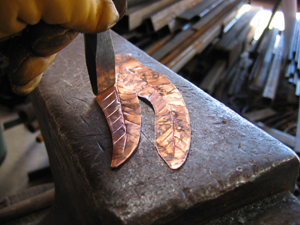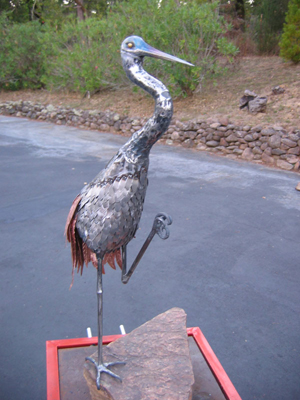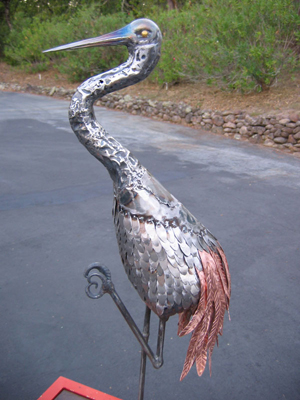10-14-2008

A close-up illustrating part of the process involved in creating one of the tail feathers. Here, I am creating a bit of texture with a chisel on the anvil. I decided to use copper for the Crane's tail feathers, as I feel it will provide a nice contrast in color with the steel feathers adorning the remainder of the body. Additionally, copper is easier to form and shape than the steel.

Another angle depicting how things are beginning to shape-up. Although it may not appear as such; there are literally hundreds of feathers already in place in this photo! Each one, individually hand-cut, shaped and spot welded into place in an overlapping fashion. I spent approximately 10-12 hours snipping little pieces of oblong-shaped "feathers" from a sheet metal to get to this point (not counting the tail feathers). Have you ever used one of those hand exercisers? Try a couple thousand repetitions in one day.... whew!

Next, I will make a template for the general shape of the wings from cardboard. I am thinking of overlapping a few layers of thin steel; each layer being staggered, with the long wing feathers slightly
overlapping the copper tail feathers in a diagonal fashion. Once the layers meet at the center of the back, I will cover the attachemnt area with the smaller feathers and continue along the back and up the neck with successively smaller feathers.
I realize this is difficult to visualize, so I guess you will have to hang tight for a couple of days until I have completed this phase of the project and
have another photo posted...
Another thing: my friend (whom has been following this project and providing me with suggestions - based upon her years spent raising birds), has noticed that the back claw is too long. I will need to section out about one third of the length and spice it back together. Now, I am trying not to get carried-away with too much detail - as this is not taxidermy - however, I feel that this is a valid point and warrants modification. I like to think of having captured the bird in motion (e.g. going into a roost position). Remember, in nature, there are an infinite number of positons this bird could have been in at any given moment. How you perceive it - depends upon when you blink your eyes...